Volume specific characterization of human skin by electrical immittance
a technology of electrical immittance and human skin, which is applied in the field of volume specific immittance measurement system on human skin, can solve the problems of inability to use conventional techniques to measure the described method does not provide the possibility of mapping the characteristics of skin layers through impedance measurements, and the system is impractical
- Summary
- Abstract
- Description
- Claims
- Application Information
AI Technical Summary
Benefits of technology
Problems solved by technology
Method used
Image
Examples
example 1
Live Finger Detection
In any electronic system for fingerprint recognition, it will always be important to be able to detect the presence of a dummy finger or a dead (cut-off) finger. While a dummy finger made of a material like e.g. rubber would be rather easy to detect with any one of several different techniques, a thin layer of pattern-imprinted latex covering a real, living finger would be a greater challenge. Such a finger would share most characteristics with a genuine finger, like e.g. temperature, blood pulse, etc. Any conventional electrical immittance measurement (like e.g. the one described in U.S. Pat. No. 6,175,641) will also easily fail if the user e.g. applies some moisture (e.g. saliva) on the latex surface.
In the case of a dead (cut-off) finger, the most obvious differences to a living finger are that a living finger presumably is warmer than a dead one, that a living finger will have blood pulse and that this blood will be oxygenated. Research has furthermore shown...
example 2
Skin Hydration Measurements
Skin function is extremely dependent on the hydration state of the epidermal SC. By monitoring the hydration state of the stratum corneum, an early diagnosis of non-visible skin conditions may be accomplished. In addition, measurement of SC hydration is also important in the evaluation of the effects of topical formulations like e.g. skin moisturisers.
We have earlier developed an electrical method for skin hydration measurements, based on low frequency susceptance measurements (see e.g. U.S. Pat. No. 5,738,107). There is reason to believe that multi-frequency measurements on SC will provide additional information that may be useful in the assessment of SC hydration and condition, but the fact that multi-frequency measurements on pure SC in vivo has been impossible to accomplish until now, has prevented further investigation in this area.
The invention described here will thus enable focused multi-frequency measurements on selected skin layers like e.g. the ...
example 3
Localized Measurement of Exogenic Electrodermal Response
The sweat activity on palmar and plantar skin sites is very sensitive to psychological stimuli or conditions. The changes are easily detected by means of electrical measurements and since the sweat ducts are predominantly resistive, a low frequency or dc conductance measurement is typically used in electrodermal response (EDR) measurements.
The lie detector is perhaps the most commonly recognized instrument where the electrical detection of EDR activity is utilized. There are, however, several other applications for such measurements, mainly within the two categories; neurological diseases or psychophysiological measurements. Examples of the first category are neuropathies (e.g. diabetes), nerve lesions, depressions and anxiety. The latter category may include emotional disorders, pain assessment and lie-detection.
EDR measurements are conventionally performed with skin electrodes that are much larger than the area typically occu...
PUM
 Login to View More
Login to View More Abstract
Description
Claims
Application Information
 Login to View More
Login to View More - R&D
- Intellectual Property
- Life Sciences
- Materials
- Tech Scout
- Unparalleled Data Quality
- Higher Quality Content
- 60% Fewer Hallucinations
Browse by: Latest US Patents, China's latest patents, Technical Efficacy Thesaurus, Application Domain, Technology Topic, Popular Technical Reports.
© 2025 PatSnap. All rights reserved.Legal|Privacy policy|Modern Slavery Act Transparency Statement|Sitemap|About US| Contact US: help@patsnap.com



